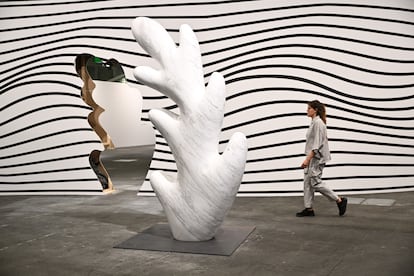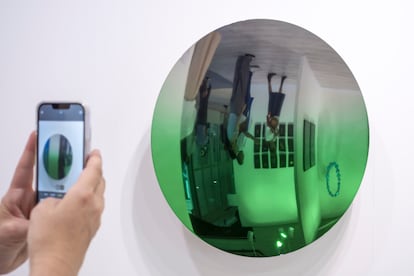Crossing that valley of ashes that is the Spanish market of contemporary art, above, in full Alps, Art Basel (Art Basel, 2025) closed last June another edition of great sales. Switzerland is a safe for the gallery owners. Safe transactions. Despite geopolitics, war in Ukraine, the Middle East or Trump’s tariffs. The jets Private continue to land with the big collectors. But this year there was a difference: artificial intelligence has arrived. It allows you to know instantly the final price of any work that has been auctioned in the world. The collectors use it to know the remaining values because the data they collect come only from auctions, since gallery prices are not facilitated to these platforms. They are left out, for example, emerging artists. There the cost is established between gallery owner and client when they stay alone by dialoguing with the grammar of money.
Jorge Pérez (Cuban American), main real estate promoter on the east coast of the US, and his wife, Darlene, hepatologist, grandmother of Canarian Grandma, are one of the most anticipated collectors and patron in Basel in Basel. They buy, and a lot. Pérez carries a phone, with a dark plastic lid, in which, ordered by the artist’s name, he refers the works they possess. In that terminal there are hundreds and hundreds of pieces. If you see one that interests them, she sends her to her team of commissioners led by Patricia Hanna (she has her own museum, Pérez Art Museum Miami or Pamm and also space 23). On the mobile phone lives one of the largest private collections in the world of contemporary art, owned by one of the Latin Americans (2.6 billion dollars, about 2.2 billion euros, according to the magazine Forbes) richer on the planet.
This year, in Basel – Revela – has acquired 24 pieces for a value of 643,904 dollars (549,800 euros). And there are still two works by the American painter Wade Guyton (Indiana, 1972), who can multiply that figure by two, and a Mural of Peruvian Claudia Martínez Garay (Conversations2025). The terminal offers them the information they need past auctions. “It is an instrument and gives you a series of data, although it is chosen with your heart,” says Pérez in front of a work in the section Art Unlimitedwhich shows the largest pieces and facilities.
For some years, it is common to see collectors, such as Jorge Pérez and his wife, using comparators. But it has broken down, with more curiosity than strength, artificial intelligence. The mutualart.com platform is one of these applications that uses AI. The only one – according to its own statements – of the market. “The AI will affect the purchase of art in many ways, mainly through a combination of the ability to identify and classify data in unprecedented forms, and unlimited access to literature, history and art prices,” reflects such Yahav, product director of Muttutuart.com. And he adds: “The most significant impact is the ability of AI to capture the essence of a work of art identifying its main motifs, objects and styles. Subsequently, huge sources of artistic information can be accessed to classify the work.” Another advantage is the ease of instantly knowing, based on repeated sales history, the price of the same work or similar pieces.

Artificial intelligence will not reduce speculation about artists and is still far from predicting the future of a creator or a work. “However, these platforms do not replace experience and knowledge, so collectors who are starting should not only trust AI,” says Monica Heslington, head of art and collecting of the Goldman Sachs Private Wealth Management Bank. “They should also consult experts to provide context to the price data and the background information provided by AI, and that, in addition, analyze whether there is any potential problem with the origin, authenticity or the state of conservation.”
It is the old vindication of connoisseur of a lifetime. “They are useful references, but they are basically only that, references, choosing will always have more things into account than possible economic predictions,” observes Maribel López, director of Arcomadrid. The collector (450 works) Paco Cantos uses the Artsy platform. “It is a guide, in the end, I make the decision. The only artificial intelligence I trust is in my own successes and in my own mistakes,” Zanja. It is non -mathematics art.

